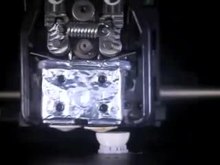Fused Deposition Modeling
Fused Deposition Modeling ( FDM ; German: Schmelzschichtung ) or Fused Filament Fabrication ( FFF ) describes a manufacturing process from the field of 3D printing with which a workpiece is built up in layers from a meltable plastic or - in newer technologies - from molten metal.
Procedure
This method was developed by S. Scott Crump in the late 1980s and used commercially in the 1990s. The term "Fused Deposition Modeling" and its abbreviation FDM are registered trademarks of Stratasys. An alternative name for this process is Fused Filament Fabrication (FFF) and was coined by members of the RepRap project in order to enable the use of the word without trademark rights.
In the "melt layer" process, a grid of dots is first applied to a surface, similar to a normal printer. The points are created by liquefying a wire-shaped plastic or wax material by heating, applying it by extrusion using a nozzle and then hardening it by cooling at the desired position in a grid of the working plane.
A body is usually built up by repeatedly tracing a working level line by line and then shifting the working level upwards in a 'stacking' manner so that a shape is created in layers.
The layer thicknesses are between 0.025 and 1.25 mm, depending on the application. Solid and hollow bodies can be manufactured. The wall thicknesses that can be produced for a hollow body are, however, limited due to the process, depending on the 3D printer - e.g. B. to at least 0.2 mm.
When the model is produced in layers, the individual layers combine to form a complex part. With this process, cantilevered components can only be created with support structures made of cardboard , polystyrene or the like or with support structures added by the 3D printer.
Materials and data
Mold waxes and thermoplastics such as polyethylene, polypropylene , polylactide , ABS , PET G and thermoplastic elastomers can be used for the FDM process . In another variant, the filaments are filled up with metal powders and the printed component is then sintered in order to obtain a purely metallic structure. In FDM 3D printing with metal from Desktop Metal, metal rods encased in wax are heated and extruded to create a green compact . After removing the support structure, the component is sintered and thereby compacted.
Practically all FDM 3D printers process G-Code, a plain text format common for controlling CNC systems, which can be generated from common 3D CAD data formats such as STL or OBJ data of a workpiece or model using slicers .
Process variants
A new type of FDM is the principle of "droplet stratification". Instead of strands, melt droplets are generated and placed point by point.
A further variant is processing of the FDM method in the absence of atmospheric oxygen, i.e. under a protective gas atmosphere (e.g. nitrogen or argon ). This is common with selective laser sintering (SLS) due to the high temperatures that occur. When the FDM-3D printer is operated under protective gas, improved adhesion of the printed plastic layers to one another can be achieved.
The end result - a model of the spine created with data from the MRI .
Web links
Individual evidence
- ↑ Wilfried König , Fritz Klocke: Manufacturing process 3, removal and generation. Springer-Verlag: Berlin, Heidelberg 1997, ISBN 3-540-63201-8 , p. 240.
- ↑ a b Christian Bonten: Plastics Technology - Introduction and basics. Hanser Verlag, Munich 2014, ISBN 978-3-446-44093-7 .
- ↑ Metallic 3D printing using Fused Filament Fabrication (FFF) - Fraunhofer IFAM. Retrieved August 22, 2017 .
- ↑ http://encee.de/3d-drucker/metalldrucken/studio-system
- ↑ https://www.desktopmetal.com/
- ↑ Felix Lederle, Frederick Meyer, Gabriella-Paula Brunotte, Christian Kaldun, Eike G. Hübner: Improved mechanical properties of 3D-printed parts by fused deposition modeling processed under the exclusion of oxygen . In: Progress in Additive Manufacturing . 2016, ISSN 2363-9512 , p. 1-5 , doi : 10.1007 / s40964-016-0010-y ( springer.com ).






